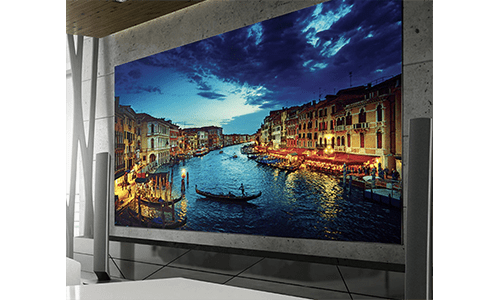7 MicroLED Solutions for Home Theater.
Video experts point to the growing microLED display category as the next big thing (excuse the pun) in the home theater category.
 Samsung has been at the forefront of bringing microLED solutions from the commercial market into the residential market through the introduction of The Wall product at CES a number of years ago.
Samsung has been at the forefront of bringing microLED solutions from the commercial market into the residential market through the introduction of The Wall product at CES a number of years ago.Everyone one loves home theater. You don’t need to be an audiophile or videophile to appreciate the benefits of a nice home theater, all you need is a love for movies and music and a large microLED display.
As the custom installation market pushes next-generation technologies into the mainstream through trade events such as the CEDIA Expo, which puts a spotlight on emerging solutions to enter the market, microLED displays are poised to be the next big thing.
This past fall in Dallas, serves as a perfect example where numerous large-display products were shown at CEDIA Expo 2022 from a variety of manufacturers. The emergence of next-generation microLED displays, which likely started around 2018 coincides with an ongoing trend that’s been happening over the past several years with homeowners choosing to buy larger televisions.
Noting this consumer preference for larger screen sizes back in episode #124 of the CE Pro Podcast, the “Video Guys” were previewing the CEDIA 2022 Expo. The experts—Joel Silver of the Imaging Science Foundation (ISF), Jason Dustal of Murideo, and Robert Zohn of Value Electronics—discussed the trend in detail, and Silver noted during the episode that 65-inch TVs are the market’s new 42-inch television in terms of sales. He continued by stating that homeowners are increasingly aspiring to own 90- to 100-inch televisions.
Examining where the home AV market stands today, with the convergence of microLED technologies and the public’s desire for larger screen sizes, the timing seems perfect for the residential technology industry to adopt solutions that were originally intended for commercial applications.
What is MicroLED?
Before getting into the products that are currently available, here’s a quick look at how microLED works. Recently Dustal discussed the growth potential of microLED in the residential market, and he explained how the technology works. Dustal started his explanation by pointing out how existing LCD technologies rely on a backlight to produce light for an image. The color component of the image he stated comes from the technology’s backlighting passing through the LCD structure. This design makes for a bright image he explained … but these images can lack deep black levels he added.
Conversely, he boasted that microLED takes a much different approach to produces higher brightness levels, deeper blacks and increased levels of dynamic range.
“MicroLED works in a different way. Each pixel is an LED. When a scene calls for a dark or black scene, each pixel can completely turn off, giving extraordinarily good dynamic range and contrast,” explains Dustal.
“Good dynamics also have a role in good color to give us deep, saturated color even in the darkest parts of the picture.”
Looking ahead, the good news with microLED besides its attractive picture quality is that Dustal, along with other experts estimate that not only will these displays continue to improve, but they will also continue to fall in price as the market for these products expands.
More news from CE Pro: Hisense 2023 Product Line Includes New Laser Products
For those interested in some of the options that are currently available in the microLED display category here are seven products from the product category’s biggest names.

